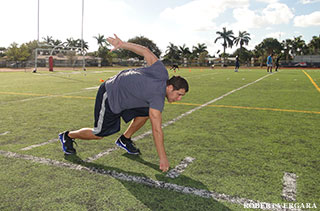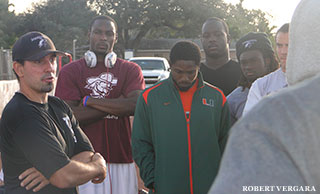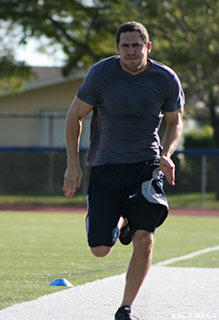
By: Jon Finkel
There are four coaches with stopwatches, one stationed every 30 feet along the 40-yard path. There is a guy with a video camera. There’s a woman with a still camera and my camera man. There are two assistant coaches. There are 14 of the best NFL running back prospects in the country sitting on two benches. That makes 23 people watching. If I was running the 40-yard dash at the actual NFL Combine in Indianapolis, there might be 2,300.
I bury my right hand into the turf, stagger my feet and bring my left arm back and up behind my body as nearly every NFL prospect has done. I take a deep breath and try to visualize my sprint as I was taught, going through all of the motions we spent the last hour working on … but my mind keeps wandering.
The Kansas City Chiefs aren’t monitoring my results. Drew Rosenhaus isn’t calculating my draft status. In fact, whether I rip it down the line for a personal best or I do the chicken dance for 40 yards, my time won’t affect my salary one bit. And yet, the scrutiny of my peers (for the day) and the pressure to perform (pride) and the number of people analyzing my run have me taking the timed event seriously. I set out to sample a day in the life of a running back preparing for the 40 at the NFL Combine and this, even without a seven- or eight-figure contract hanging in the balance, is what it’s like. I force myself to focus on each element of my start. Fire my arm. Drive my plant leg. Keep my chin down. Tighten my core. Run.
5.12 seconds later, it’s over. I try to imagine how I’d feel knowing that I missed out on millions of dollars because I didn’t run a 5.02. I can’t.

***
It should take you about two-tenths of a second to read the word “tenth” in the phrase “tenth of a second.” It’s an almost imperceptible amount of time that can bolster or break a running back’s draft position. Between the 40-yard dash, the three-cone drill, the 20-yard shuttle run and the 60-yard shuttle run, half of the events at the NFL Combine are measured using tenths and hundredths of a second in the results. With those numbers figuring heavily in a player’s draft status, speed pays, and since the NFL is a billion-dollar business, speedy people are more than willing to find someone to train them to be speedier.
That someone for many current and future NFL players is Pete Bommarito, CEO and president of Bommarito Performance Systems (BPS). Bommarito has trained more than 500 NFL Draft prospects at every position and he is, as Mike James, a projected late-round draft pick out of Miami says, “the man you go to when you want to run fast.”
It’s barely 6:30 a.m. and Bommarito is setting up his electronic timing equipment for the 40-yard dash on the visitor’s side of a football field. The sensors look like two mini-strobe lights sitting on tripods on opposite ends of a running lane. They’re connected to a stopwatch the size of an old Sony Walkman that measures the results. Between checking and re-checking the connection, Bommarito explains how the process of preparing an athlete for the 40 begins.
“Everyone comes to us hurt,” he says. “If you’re not hurt, you’re not playing college football. That’s just a part of the sport. That’s why we don’t have guys throwing down 40 times on day one. After a long season and a bowl game, they all have deep bruises and scar tissue that needs to recover. The wear and tear on the joints is also hard. The hips, the spine, the shoulders, everything. You can greatly accelerate that healing process if you have the right medical care, but it’s not just about making somebody faster. If I have enough time, I can make anyone faster. It’s about getting someone to reach their genetic maximum in a short period of time, namely between their last game and the combine.”
When asked how quickly he’d like to work with an athlete after their college football career ends, Bommarito smiles and asks, “How quickly can they get here?” If it was up to him, players would take an ice bath after their last game and show up at BPS while their skin still has goose bumps. That’s how important every single day of training is.
***

Across the field from Bommarito, on the home team sideline, several dozen young athletes wait, each less than two weeks away from the most intense physical job interview of their lives. A handful of them are getting massages while the rest are spread out over three benches and 30 yards of turf. College workout gear and headphones are the uniform of the day. Hardly anyone is talking. If you remove the football field backdrop and replace it with an airport, you might think it was just a bunch of guys killing time in a terminal during a long layover.
Mike James (pictured below) is one of the players lounging on a bench. He’s part of a stellar class of running backs that Bommarito is working with this year, including Jawan Jamison of Rutgers, Mike Gillislee of Florida and Michigan State standout Le’Veon Bell. Their goal is to join the list of Pro Bowl running backs who have trained with BPS, including Maurice Jones-Drew, Frank Gore, Matt Forte, LeSean McCoy, Willis McGahee and Marion Barber. Laying down impressive numbers at the combine is the first step on that road.
“One thing you have to keep in mind is that these athletes are football players first,” Bommarito says. “Their comfort level is playing ball with 10 other teammates in front of fifty or one hundred thousand people. During training, we have to simulate the atmosphere at the combine as much as possible to get them comfortable with it. In Indianapolis, they’re in a dome. There’s no sound, no cheering. All eyes are on them as they perform alone. That’s why I take them here, to a field in the middle of nowhere, make them shut their phones off, and put them through a professional-level combine.”
The middle of nowhere field he’s referring to is the Vince Zappone Field behind the Chaminade-Madonna College Preparatory school in Hollywood, Florida. A mural painted on the side of the locker room says The Lions Den, a nod to the team’s nickname. With a high school gym class jogging on the adjacent softball field and a tractor renovating the track in the background, it has little in common with the professional Lions den at Ford Field in Detroit. This version is humble and secluded, which is exactly the point.
“I set up today so it’s a complete business atmosphere,” Bommarito says, glancing at his players across the field. “At the actual combine, teams are watching every movement these kids make. How they walk, how they talk, it’s all scrutinized. First impressions are everything. We mimic that here as much as we can. It’s just as important to prepare these kids mentally as it is physically. Nothing is overlooked.”
***
At 8 a.m. sharp, Bommarito calls all of his athletes for a quick huddle behind the benches. His speech is part drill instructor, part motivational speaker. The theme of his talk is professionalism. He wants the athletes to act as if this they were competing at the actual combine, but with one caveat: He doesn’t want his players to share their results today with anyone. Not girlfriends, not parents, not coaches. Forty times should be treated as if they were nuclear launch codes. The idea is to impress NFL scouts at the combine — not Tweet that you dropped a 4.4 in practice only to run a 4.6 on the big day. It’s Business 101; don’t set yourself up to over-promise and then under-deliver. The devil, as always, is in the details.
Having said his piece, he sends us off to the 20-yard line to start getting loose. Here, the attention to the minutia of the combine performance appears again as we spend a full seven minutes of our warm-up on just our feet and our ankles.
“Everything starts in the foot,” Bommarito says. “Speed, acceleration, it all starts from the ground up. You’re not going to perform your best if the foot is not in maximum condition.”
After the foot, we do dynamic toe presses to activate the calves, followed by movements for all the muscles above the knee, the hips, the core and the upper body. Each muscle group has its own set of drills. Some last for 10 yards, some for 20, some are performed lying down, some are done backwards, some sideways.
Every single aspect of the race has been stripped to its individual components and they’re expressed in the drills. Once all the singular muscles are primed, the activity advances to compound movements like high knee runs and glides, each progression moving us closer to a full-fledged running motion.
Once all the pieces are put together we work on our starts for about 10 minutes, focusing on arm and leg position. These guys have been honing their skills for weeks, and just like when NBA players step to the foul line, each running back has their own little rituals built into their pre-race routine. A few guys cross themselves. A few guys close their eyes and take a deep breath. A few bounce up and down lightly on the balls of their feet. Off to the side, a few men work with each other, pointing out any flaws that they catch. This is not an uncommon practice, as bonds are forged through the hardship of the workouts.
“When you’re here, you’re competing against each other directly,” Mike James says. “But really, we’re competing against every other running back in the country. We all know it’s a business, but when you’re working hard every day with someone and you’re training together, you want them to do well. We all have to do everything possible to get better and when it’s over, we hang out. Me and Gilly hang out a lot.”
Gilly is Florida running back Mike Gillislee (at left), who scored 10 touchdowns and rushed for more than 1,000 yards this past season. He and James both had an impressive Senior Bowl, and they both know that they have a torch to carry when it comes to the level of success expected from running backs at their respective schools.
“All the great running backs that went to Florida have inspired me a lot,” Gillislee says of guys like Emmitt Smith and Fred Taylor. “I’ve watched so many of them on film and looked back at what they did and I just visualize myself doing it too. At the same time, I also have to be myself and do what I can do and use my God given ability.”
James agrees.
“There are a lot of star running backs in the league from Miami,” James says. “I want to uphold that legacy and really take advantage of the opportunity. For me, I know I have to run fast. I’m not too worried about the weight stuff, because I’ve always been a stronger kid, but my goal is to go through the drills well and run a fast 40. That’s why I’m here.”
That’s why all the running backs are here, and finally, after almost an hour of warming up and perfecting our starts, we’re called over to the station to run the race itself. This is where the mental aspect of the training comes in, because while you wait your turn to run, there is far too much down time to think.
***
“What you think about when you run is paramount to performance,” Bommarito says. “We don’t want guys pressing too hard and we don’t want them focusing on the time they want to run. We want them to focus on the mentality of what they do when they step on the line. They should be able to close their eyes and visualize the entire lane, the line, the whole run. I don’t want them over-thinking it.”
Over-thinking can lead to paralysis, which is why Bommarito has built in a pre-race routine for each athlete to follow so that on race day, they have to do as little thinking as possible.
“In Indianapolis, they just call your name and you have to be ready to go,” he says. “That’s what I do here, over and over, because I don’t want any brain farts when we’re there.”
The routine goes like this: When an athlete is four spots away from racing, he starts the first of four warm-up drills that are done precisely in sync with when the runner four spots ahead of him takes off. He does one drill when he’s four spots away from racing, another when he’s three, another when he’s two, and one last one when he’s on deck. The mechanism kicks in every time the athlete hears the name of the man who is four ahead, transforming the race itself from an isolated, stress-inducing event into the natural last step in a choreographed series of drills that an athlete has performed hundreds of times. The nerves disappear into normalcy.
It’s almost enough to make the million-dollar stakes fade into the background. Almost.
***
The sprints themselves are a study in controlled analysis of movement. Every step, every arm swing, every tilt of the head is videotaped and examined to make sure runners are using the absolute most efficient stride possible to cover the necessary 120 feet. After each run, suggestions are given and adjustments are made.
Bommarito doesn’t let the athletes see their times until everyone has gone through the rotation twice. Then, and only then, does he hand over his clipboard, which is immediately swallowed up by a swarm of players. They all clutch at the board, trying to find the numbers attached to their names, which may eventually translate to the numbers attached to their contract, if they’re lucky enough to be offered one.
A few guys torched the track; a few, not so much. As the athletes sort out who ran what, there’s excitement, there’s disappointment and there’s fear.
Even in this elite group of college runners, only a half dozen or less will most likely get drafted. The rest are hoping to get an invite to an NFL team’s training camp, where they can fight it out for a spot on someone’s roster. Still, one of the quickest ways for a back to get noticed is to post a blazing fast 40 time at the combine.
“Remember,” Bommarito says to the group. “You gotta put that 40 behind you and move on to the next event. No matter what you ran, you aren’t peaking yet. We still have to taper you down for the combine. Most of you are only at 80 or 90 percent. If you don’t like your results, we have plenty of time to get better. If you like your time, don’t even think that this is your best. We have tape on everyone and I’ll watch it and let you know how you can improve. You can all go faster.”
“Faster is good,” one of the athletes says, nodding.
Yes, it is, because when it comes to the 40-yard dash, time is money.
Did you love this article? Sign up for my monthly feature here: http://bit.ly/21juoUt